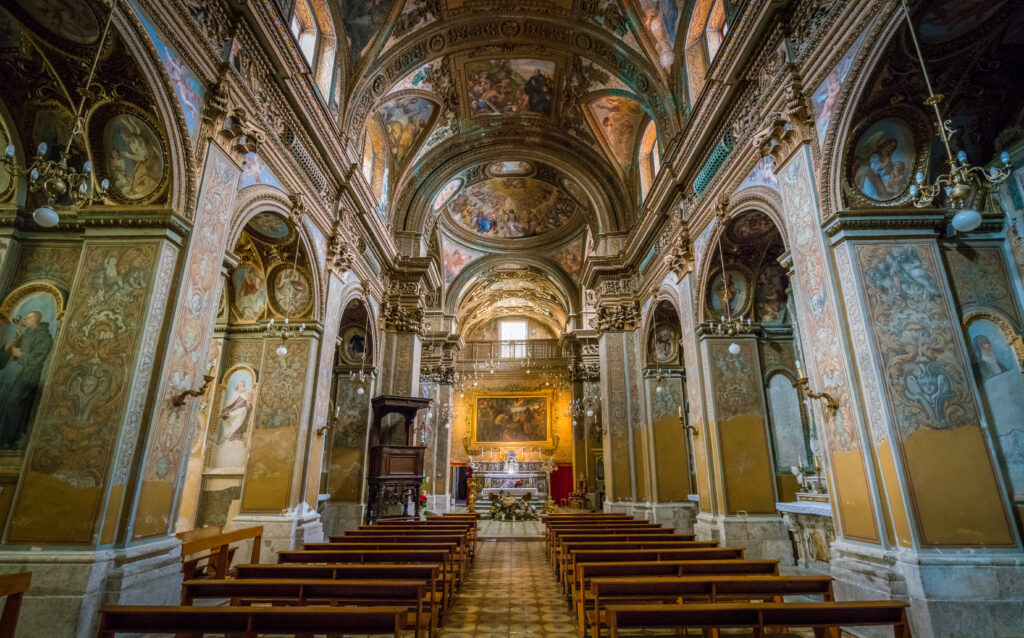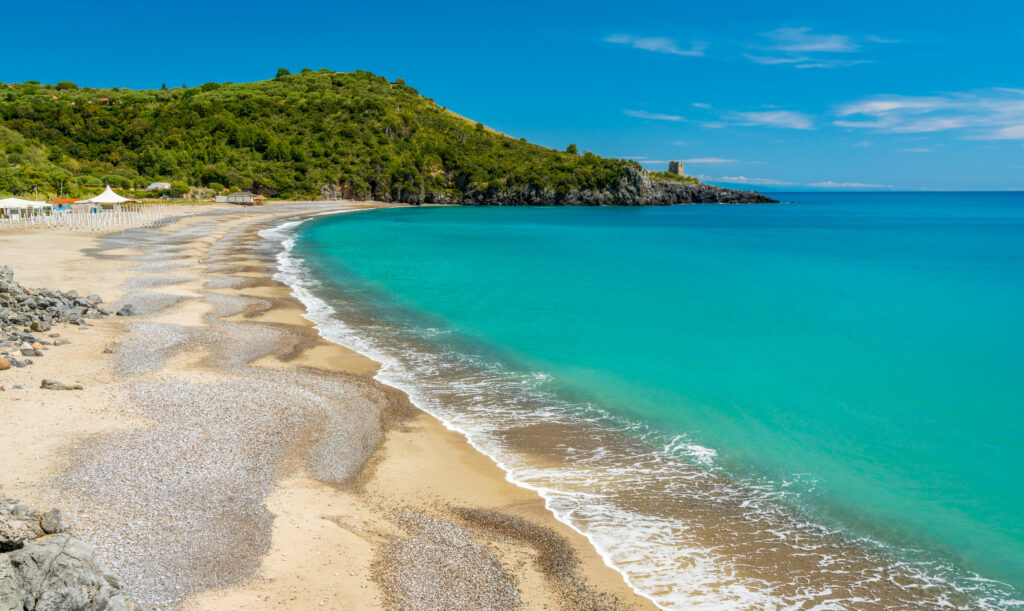
Salerno, beyond its medieval heart nestled beneath the Arechi Castle, is also rich in convents. Developed in Roman times, the town reached its apogee between the Lombard (8th century) and Norman (11th century) periods. Its medical school, famous in medieval times, contributed greatly to its renown. However, in 1812, Joachim Murat, then King of Naples, closed this institution. Salerno is also marked by a historic episode: the Allied landings of September 1943, whose bombardments destroyed much of its heritage. Although eclipsed by Naples, Salerno remains a major economic center of the region. Its historic center is charming, accommodation more affordable than on the Amalfi Coast, and the restaurants excellent.
1. Stroll through Old Salerno

After visiting the must-sees of Naples, it's time to head for Salerno! After strolling along the modern Corso Vittorio Emanuele, we reach the Via dei Mercanti, the heart of commercial activity in the Middle Ages, and still very lively today. At the time, it was called drapperia in reference to the many cloth and fabric trades that took place here. This long street, which has preserved its medieval character, features a number of vaulted passages and is lined with numerous churches and palaces with carved portals. At the far end of the old center, you reach the Piazza d'Ajello. From here, the public elevator provides access to the upper part of the town. The Minerva Gardens offer a pleasant stopover in a bucolic setting. Next, Via Torquato Tasso: here, you feel like you're in a little Naples, with its imposing palaces, some abandoned, some converted into apartments, and its unusual architectural details. Via Duomo takes you back to the city center after a visit to the cathedral.
Book my tour of the most beautiful places in Salerno
2. What to do in Salerno Castello di Arechi

Perched 300 meters above sea level, the Castello di Arechi, built on Byzantine foundations, was a key fortress under the Lombard prince Arechi II in the 8th century, before being enlarged in Norman and Aragonese times. From its summit, an exceptional panorama extends over the Gulf of Salerno and the Amalfi Coast. The hill on which it stands, called Bonadies, means "good morning", in reference to the first light of dawn that illuminates its summit. The castle also houses an archaeological museum displaying artifacts discovered during excavations, as well as a multimedia installation retracing the history of Salerno. A site not to be missed, among the must-see tours of Italy.
3. Duomo San Matteo

Founded at the end of the 11th century by the Norman king Robert the Guiscard, Salerno Cathedral 's current Baroque appearance is the result of its refurbishment after the earthquake of 1688. The façade is built around three portals, including a central one in bronze from Constantinople. Also worth a look is the 18th-century staircase leading to the Lions' Gate. Also worth a look is the splendid 15th-century funerary monument to Queen Margaret of Durazzo. As for the chapel's treasury, it contains several Gothic relics.
4. Giardino della Minerva

Perched high above old Salerno, the Giardino della Minerva (Garden of the Minerva) is a haven of peace, perfect for a stroll with the family or a romantic getaway. Its terraces, gardens and fountains overlook Salerno, offering a magnificent view of the Gulf of Salerno and the Amalfi Coast. Owned by the same family since the 12th century, this garden was once used for research by Salerno's medical school. According to some sources, it was the very first botanical garden on the Old Continent dedicated to the use of plants for therapeutic purposes.
5. What to do in Salerno Visit the Archaeological Museum

Founded in 1927, the Archaeological Museum is housed in the former San Benedetto monastery and palace of the first Norman kings. It houses a fine collection dating from prehistory to the end of Antiquity, resulting from excavations carried out in and around Salerno. Among the treasures on display are funerary furnishings from Iron Age necropolises, including Greek ceramics, weapons and jewelry. Upstairs, visitors can admire the famous bronze head of Apollo, fished out of the Gulf of Salerno in 1930. In the garden, a lapidarium displays Roman artifacts.
6. Chiesa San Giorgio, one of Salerno's finest Baroque churches

This is undoubtedly one of Salerno's most beautiful Baroque churches. Founded in Lombard times, it was later attached to a Benedictine convent whose buildings surround the church. The entrance to San Giorgio church is adorned with a Renaissance-style marble portal dating from 1560. Inside, Baroque style has invaded spaces and surfaces: gilded stucco and frescoes decorate the walls, vaults and dome. There are also impressive paintings by Andrea Da Salerno, Angelo and Francesco Solimena.
7. L'Acquedetto medievale

The imposing ruins of a medieval aqueduct, built in the 9th century to supply water to the monastery of San Benedetto, lie in a residential area of modern buildings . The original structure was around 650 metres long, with a maximum height of 21 metres. Today, two distinct segments remain, oriented differently, and cross the present-day street, once at the level of the ancient city walls. A notable detail is the use of pointed arches, a very rare feature for a building of this era.
Explore the hidden gems of beautiful Salerno on this guided walking tour.
8. What to do in Salerno Go back in time at Paestum

Poseidonia was founded by the Greeks around 600 BC, in honor of Poseidon, the god of the sea. Between 400 and 273 BC, it was occupied by the Italic Lucanian population and became a Roman colony under the name of Paestum in 273 BC. The fall of the Roman Empire coincided with the end of the town. Around 500, it was gradually abandoned by its inhabitants. Paestum was rediscovered in 1762 and completely uncovered in the 20th century. Today, it is one of the most important archaeological sites in Magna Graecia, comprising three remarkably well-preserved Doric Greek temples and a museum. Since 1998, the site has been a UNESCO World Heritage Site. After Paestum, a visit to the museum is a must. Located opposite the archaeological area, it is packed with treasures from the archaeological site, from the temple of Hera on the banks of the River Sele and from excavations in nearby Greek and Lucanian necropolises.
Explore Paestum's fascinating ruins on this tour with an archaeologist. You'll discover the Greco-Roman city with its temples, amphitheatre, forum, markets and ramparts.
9. Cilento National Park

Located at the southernmost tip of Campania, the Cilento National Park is classified as a biosphere reserve by Unesco. It is home to rare and protected flora and fauna. The park, Italy's second largest, offers magnificent landscapes with breathtaking views of the coast, as well as authentic villages and remarkable monuments, such as the Carthusian monastery of San Lorenzo and the abandoned village of Roscigno Vecchio. Let yourself be enchanted by the beauty of these landscapes and the richness of nature. To make the most of the park, the ideal place to stay is an agriturismo, perfect for a moment of relaxation in the heart of nature, far from the hustle and bustle of towns and seaside resorts. All in all, it's the perfect place to relax before heading off to discover Naples, one of Italy's must-visit cities.
Looking for an adrenalin-filled experience? Book rafting experience in the Cilento National Park !
10. Breathing fresh air on the Cilento Coast

The Cilento coast may be less well known than the Amalfi coast, its villages and Capri, but it's well worth the detour. All along the way, you'll find picturesque fishing villages and medieval towns just waiting to be discovered, which could well be among the most beautiful in Italy. Let yourself be carried away by the clear blue waters, considered to be the cleanest in Italy. Here you'll find immense beaches with fine sand and heavenly coves. Prefer May to late September, as most places are closed in autumn and winter. The best way to discover the coast and the whole of Cilento is by car: you can drive down the road that runs along the coast.
11. Enjoy Italian gastronomy

Neapolitan cuisine is one of the most esteemed in Italy, and the region is responsible for many specialties that have spread far beyond the country's borders. It's largely open to the sea, featuring fish, seafood, citrus fruits and olive oil... But the fertile valleys of Campania are also a paradise for lovers of pork, cheese, pulses and fruit. Populated by Greeks, Romans, Goths and Byzantines, the region was the preserve of the Spanish and then French crowns, who introduced new, exotic ingredients such as tomatoes, which are used to garnish pasta and pizza, the two emblems of Campania. Added to this are excellent, gourmet desserts that Neapolitans always enjoy with coffee, and, of course, quality wines and liqueurs. And, since 2017, the art of the Neapolitan pizzaiolo has been classified as an intangible heritage of humanity by Unesco. It's undoubtedly one of the culinary specialties to discover in Italy. Buon appetito!
Where to stay in Salerno?
- The most central: theHotel Plaza
The Plaza is an extremely functional establishment, elegant without overdoing it. The rooms are unpretentious, but very clean and comfortable. The staff are friendly and helpful. In short, a safe and reliable address that fits the bill perfectly, which you can book right here.
- Most convenient: relais Vittorio Veneto
This brand-new establishment offers spacious rooms and studios with kitchens , bookable right here. The plus? The excellent location, just a stone's throw from the railway station and the port from which boats depart for the Amalfi Coast. Breakfast is served in a nearby bar.
- The quietest : villa Rizzo Resort Spa
This ancient farmhouse has been completely restored in the heart of a 12-hectare park of olive and hazelnut trees. The rooms you can book here have a terrace or balcony overlooking nature. A beautiful spa to relax in and an elegant outdoor swimming pool to enjoy the fresh country air. In short, an ideal place to spend a relaxing vacation halfway between the region's main cultural sites.
What to visit around Salerno
This part of Campania has everything to please you. As well as Salerno, with its historic center and shopping streets, there's the ancient heritage of Paestum. And let's not forget the seaside resorts of the Cilento coast, surely one of the most beautiful landscapes in the Mediterranean. Cilento is also about nature and parkland, caves, waterfalls and hills where time seems to have stood still, like the deserted village of Roscigno Vecchio. It's also ancient villages, where peace and tranquility reign, where quality of life and good food are cultivated. In short, it's a diamond in the rough, where mass tourism has yet to arrive, as in other Italian spots, where it's still possible to escape the crowds.
Discover also the most popular things to do in Salerno:


